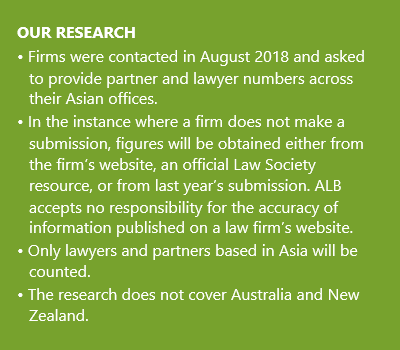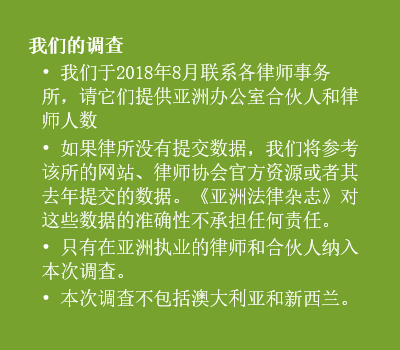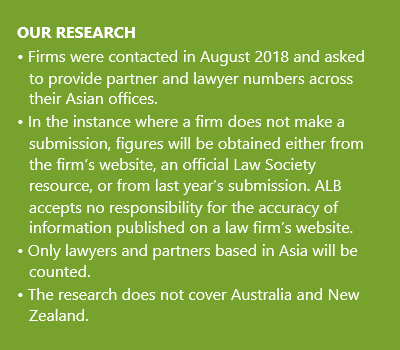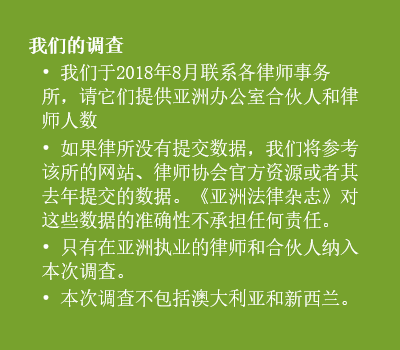
While size has its advantages, China’s law firms are realising that headcount growth is not critical to their success.
The 2018 ALB Top 30 China Domestic table gives a glimpse into the size and scale of the growth strategies of Chinese law firms. With some having grown faster than others, it is clear that some firms have emphasised this strategy while others have not.
After years of high quantitative growth, Chinese law firms are now focusing on qualitative growth: growing larger and becoming stronger. It appears to be mostly based on the conventional notion that market specialisation and recognition follows on from quantitative growth. Growing in size is an inevitable result of becoming and maintaining a full-service firm, and it can be an indicator of not just the breadth of services provided by the firm but also how well it is doing.
The 2018 ALB Top 30 China International table reflects the increasing importance of China’s legal market to international law firms. In 2018, some firms scaled down a bit on hiring additional legal professionals in comparison to 2017, while others went on a hiring spree this year, including one which grew by 125%, and five firms joined the group with one immediately climbing up into top 10. Firms are developing a clearer market strategy with both their platform and branding attracting more Chinese legal elites.
In this report we analyse the changes in the ranking tables, investigating what leads Chinese law firms’ growth development and what strategies are being employed by international firms in China.
Changes in headcounts, our sole metric, are not simply mathematical. Every decision to change, to preserve, on the rate of change, offers us a window to better understand today’s legal service market.
 CHINESE FIRMS: TO GROW OR NOT TO GROW
CHINESE FIRMS: TO GROW OR NOT TO GROW
As seen in the past five years, the growth curve is not always linear. Some firms dropped a bit in certain years but the trend is on spiralling upwards.
Some firms showed a bit of concern towards the decline in their numbers. In the minds of many law firms’ leaders there is an assumed correlation between a good momentum and the headcounts in steady increase. We would rather interpret this as a healthy adjustment, especially for those firms implementing integrated management.
This year’s annual list saw three firms joining the top ranks: Hui Ye Law Firm, China Commercial Law Firm, and V&T Law Firm, at 23rd, 27th and 28th spot, respectively, with three firms dropping: Tianyuan Law Firm, JunZeJun Law Offices, and Global Law Office. Hylands Law Firm, with 207% growth rate, is a big mover this year, jumping to 13rd from 30th position last year.
The mid and bottom half table is also jammed, with some firms ranking above their peers just by having one to four lawyers more than their rivals. Zhongwen Law Firm kept its 30th place by having one lawyer more than East & Concord Partners.
One-third of firms retained their places with slight changes in the top four. Yingke Law Firm once again took the top spot, followed closely by Dentons with Deheng Law Offices and AllBright Law Offices keeping their third and fourth spots, respectively.
Yingke had 892 fewer lawyers than Dentons in 2013, but led the 2014 rankings with a 72% growth rate. The rankings took a turn in 2015 when Dentons stepped into the top position but since 2016 Yingke has cemented its place as the largest law firm in China.
Yinke and Dentons keep third-placed Deheng or Zhongyin at arm’s length. In short term, the two largest firms will see no competitors. Yinke continues its expansion to the total number of 14,000 lawyers by 2021. The firm will achieve a 113% growth rate by headcounts based its current 6,584 lawyers in 2018.
Yingke’s expansion strategy is not only base on keeping their headcount high. The firm is also improving its network by strategically charging its way into legal markets across China. “We achieved a milestone progress in 2014 and we now become the largest law firm in Asia and fifth largest in the world. In 2015, we started penetrations into China’s second and third-tier developed cities by mergers.” The managing partner of Yingke tells ALB.
Dentons is aiming to enhance its speciality and branding with a steady increase in headcount too. The firm recently announced its promotion of 26 senior partners and one senior counsel. The firm opened its Lanzhou office in Gansu province in September 2018, marking the completion of its legal service network across China with the Beijing-headquartered office plus 44 offices in all major cities.
According to Dentons, “Prior to the merger with Dentons in 2015, the firm was already one of the largest law firms in Asia. After the merger, we set the goal of turning the firm from the largest into the most leading. Now we start to enjoy the benefits of our one global law firm.”
Deheng held on to its third spot since 2016, expanding to 2521 qualified lawyers. AllBright has also secured its fourth spot since 2016, with 2338 lawyers. The gap between the two this year is very narrow.
Zhongyin finished at number six from last year’s number eight, nudging King & Wood Mallesons down to number seven. The firm keeps expanding in the past five years but was edged out from the top 3 from 2016 onwards by firms such as Deheng, AllBright, King & Wood Mallesons, Zhong Lun and Grandall.
“We will continue expanding our team as we grow the business. Size matters as it helps to explore the market and to expand the business, but there is no clear-cut answer to what the optimum size is for a law firm. It is decided in several dimensions such as the strategic goal, the management system, etc., but a wild expansion will only bring risks.” says the management of Zhong Yin.
This is one of the negative points that a sizable firm is linked. And the risks also include the loss of collegiality. According to research, however, the real issue is that there is virtually no correlation between size and collegiality. As law firms grow, attachment to the overall firm is replaced by attachments to a practice group within the firm. Collegiality is lost as a firm grows at a point somewhere around 100 lawyers or more is not true.
Beijing DHH Law Firm also bulked up, moving up one place to number 8 with total number of lawyers to 1306, registered an increase of 12%. The firm made its first entry into the top 10 in 2017 with a growth spurt of 68% compared to 2016.
DHH’s slow expansion means the changes the firm made on its development strategy. Expansion at an exponential rate was the firm’s temporary goal when it was starting, then some growth pain surfaced along the way. Despite a temporary slow-down in growing its numbers, DHH now is a sizable law firm in China boasting nearly 40 offices with a total number of 1500 lawyers across the globe.
“For a sustainable growth, DHH should slow the pace. This is not in conflict with our vision of becoming a global high-end commercial law firm that provides one-stop shop to our China and international clients. The current size of DHH is far not enough to reach that goal but DHH will prioritize growing stronger over growing larger at this stage,” observes Kejiang Liu, director, supervisor of international practice and senior partner of the firm.
Zhong Lun Law Firm pursued a stable growth all these years and finished at number 10 with 1,211 lawyers. The firm never achieved growth at the cost of revenue per lawyer (RPL) as an expansion strategy. According to Zhong Lun, their annual headcount growth rate should be about 50% of the firm’s growth rate of total revenue, then the firm’s annual profitability would not suffer and the firm’s revenue per partner (RPP) would not decrease.
“Some firms weren’t included in the top five when it comes to the headcounts but they would be in the top five when it comes to the total revenue. It is a question of RPL, RPP, profit equity per partner (PEP), or management efficiency. Zhong Lun takes a middle road in both headcount growth and revenue growth.” says Wenjun Qiao, executive director of Zhong Lun.
Hui Ye Law Firm, one of the new entrants this year, is another interesting firm to watch. It registered at number 23 and, in the past two years, was also the winner of ALB fastest growing law firms. The firm follows a growth strategy that features strict quality control and industry-driven expansion.
According to Guosheng Yang, managing partner of Hui Ye, “finding one’s own expansion pace is important. It’s like climbing mountains, landscape is always alluring but we should know our limits.”
A number of managing partners told ALB that growing in size is not just an option but an inevitable path, which rings particularly true to full-service firms. The question involves three dimensions: is there an optimum size for law firms? any indicators to define the optimum size? what major advantages a sizable firm could bring?
According to our interview results, size has six major advantages, namely:
- larger firms can provide service across all major practice areas;
- larger firms are more risk-resilient with multiple revenue streams; larger firms have better partner structure thus leading to better synergy;
- larger firms are more capable to meet the evolving and sophisticated clients’ needs;
- larger firms have better reputations and name recognition; and
- larger firms have more resources and are more capable to solve the problems when firms grow.
Although there is no concrete indicator to measure what the allowable optimum size law firms should have, Wenjun Qiao points out that, “there are two benchmarks for references. Firstly, the expansion will not be in conflict with management efficiency and risk control; Secondly, the expansion will not dilute RPL and the annual growth rate of total revenue. ”
Guangzhou-based ETR Law Firm finishes at #21, same as last year, increasing by 34% on headcounts. Xiaohua Wang, the director of ETR Law Firm adds another benchmark, “the headcounts of ETR has been kept under control about the percentage of one-twentieth of the total numbers of lawyers in Guangzhou for the sake of avoiding any conflicting interests. ETR’s expansion in China and beyond will depend on the marketing demands and the firm’s management capability.”
INTERNATIONAL FIRMS: QUALITY OR QUANTITY
Except in 2014 when Hogan Lovells landed on the second place, Baker McKenzie and Clifford Chance dominate the top spots for the past five years. This year, Baker McKenzie continues to lead the list despite having four less lawyers than last year, while Clifford Chance missed the crown by having one less lawyer with 72 in total. Morgan Lewis & Bockius finished on third with 60.
Morgan Lewis & Bockius is a big mover with 275% growth, jumping to 60 lawyers from 16 in the last two years attributed to its mergers in 2014 and, again, in 2015.
The other three fastest growing firms in the rankings for the past 12 months are Paul Hastings which increased by 77%, Kirkland & Ellis at 125%, and Sidley Austin’s 100%.
Paul Hastings’ notable move catapulted it to the eighth spot from twentieth last year. After adding three corporate partners in the Asia-Pacific this year, the total number of lawyers rose from 22 to 39.
Kirkland & Ellis rose to number 11, which shows it values the market in Asia-pacific. As early as 2011, the firm expanded its Hong Kong team by adding eight senior M&A lawyers. Without adding new partners this year the firm still had 20 more lawyers than last year.
Sidley Austin saw its place rising to number 17 from 29 with 13 more lawyers including one partner hire from Hogan Lovells this year.
Hogan Lovells dropped out of the top five from last year, which attributed to several lawyers leaving in 2017. According to some sources, the firm closed its Mongolia office last year. Its corporate partners left for Squire Patton Boggs and Simmons & Simmons. Despite the talent drain, Hogan Lovells remains number six in the table this year with the total number of 41 lawyers.
New entrants this year include Stephenson Harwood, Skadden Arps Slate Meagher & Flom, Squire Patton Boggs, O’Melveny & Myers and Duane Morris & Selvam.
Stephenson Harwood took the seventh spot after hiring real estate partner Catriona Berman and capital markets expert Allen Shyu and his 11-lawyer team this April in its Beijing office.
The five firms, edged out of the top 30, were Covington & Burling, Sheppard, Mullin, Richter & Hampton, Mayer Brown JSM, Freshfields Bruckhaus Deringer, and Pincent Masons. Covington & Burling and Sheppard, Mullin, Richter & Hampton are two firms that made the first entry last year at number 12 and number 21, respectively, but were both trimmed from the top 30 this year.
Norton Rose Fulbright and Bird & Bird, slipped down to number 29 and number 26 from number 14 and number 16, respectively, although they only decreased eight and five lawyers in total this year.
Firms in the Top 5, however, present a different picture. Simmons & Simmons and DLA Piper still managed to finish at number 4 with 48 lawyers and number 5 with 47 lawyers, respectively, after losing 10 and 15 lawyers in total this year. The two firms also boast the largest partner cohort in the table.
The last five-year ALB rankings show that there is a headcount gap between top 5 or top 7 and the rest in the table, while among the rest, the differences in headcounts are negligible. On instances where the firms have the same number of lawyers, the firms with the greater number of partners were ranked higher.
ALB interviewed the top three firms as we believe their growth and strategy in China would provide valuable insights to better understand China’s legal service market and its future.
“Our strategy in China is quite simple: to be the leading combined international/local law platform in China, delivering seamless, top quality international and domestic capability, focused on cross-border and high-end domestic work as trusted advisers for MNCs and PRC clients. To achieve this objective, we established Baker McKenzie FenXun in 2015, the first Joint Operation platform between an international law firm and a Chinese law firm,” says Milton Cheng, managing partner of Baker McKenzie’s Hong Kong office.
Over the past three years, the total number of Baker McKenzie and FenXun lawyers has increased from 109 to 176. “We will continue to grow our Joint Operation platform to ensure that we meet our clients’ evolving needs, as well as our transactional practice capability in China, which is an area of real strength for our firm, and the best way to do so is to deepen our partner bench. The optimum size is dictated by the capabilities our clients expect us to deliver, where those services are needed, and the level of demand for those services.” Milton Cheng adds.
Clifford Chance’s China strategy has been consistent over the years and is based on steady, sustainable growth driven by client needs. Clifford Chance was the first international law firm to open an office in Beijing in 1985 and in Shanghai in 1993. Over the past three decades, the firm has a well-established and successful China practice and their Chinese clients see their on-theground capability to execute deals as a differentiator.
China is critical to Clifford Chance’s growth strategy in Asia Pacific and globally. The firm continues to build up its team by promoting Hong Zhang and Yong Bai, who are part of the six partners promoted across Asia Pacific, as new partners in mainland China earlier this year.
Terence Foo, China Co-Managing partner of Clifford Chance, told ALB that, “In terms of recruitment, we continue with our long-term strategy of recruiting the brightest legal minds, offering unrivalled training and exposure, and developing our local talent to become world class international lawyers.”
In recent years, Clifford Chance has seen a steady flow of work from their Chinese clients who are “going out”, including leading Chinese SOEs, POEs, technology companies, funds and financial institutions. To serve these clients well, the firm has developed a sizable bilingual team on-the-ground in mainland China across all major practice areas. “This enables us to have advised our clients who have undertaken high profile and milestone transactions,” Foo tells ALB.
“Strengthening our regional presence in China and throughout Asia is key to developing our global business but our growth is driven by what our clients need and where they need us to be. Every new office and lateral partner addition at the firm has been, and will continue to be, part of a strategic decision to meet and anticipate client needs. It is clear from the work we are already undertaking for both Asia and multinational companies operating in the region, that China is a key component of their own growth strategies, so that will likely continue to be the case for us too,” Mitch Dudek says, office managing partner in Shanghai at Morgan Lewis.
HOW TO RECRUIT EFFECTIVELY
The percentage of partner addition from internal promotion or lateral hires tells a lot about law firms’ recruitment and growth strategy.
From our interview surveys, Firms like Hui Ye, Dentons, TianTai, ETR and Zhong Yin maintain a balance as they see values on both sides. At Hui Ye, their first-generation partners, partners from internal promotions, and partners from lateral hires all take up one-third in headcounts. “This year we promoted more than 20 partners and in the meantime our internal promotion pipeline functions well. Next step, we aim to explore EU and South East-Asia market,” Guosheng Yang says.
“We didn’t set up any fixed percentage in this regard. It all depends on the demands of our clients, and whether the expertise and the outlooks of the partners fit with Dentons’.” Dentons adds.
He Zhang, director of the managing committee of Beijing TianTai Law Firm adds that “Firms should expand their partnership both internally and externally. We will continue on increasing the total number of our lawyers. Like many conventional firms, we achieved the integration via mergers and will identify our development path by achieving a better integration. It’s a long way ahead but our core value will never change.”
The same principle applies to ETR and Zhong Yin. Lateral hires are important in adding and strengthening their practices while internal promotion pipeline is well guaranteed.
Firms such as Zhong Lun and DHH prefer internal promotions to lateral hires. At Zhong Lun, the current percentage is 4:1 and will increase to 5:1. In the case of DHH, the current percentage is 8:2. The two firms emphasise the importance of a shared value and vision with their own people, but this does not mean they are not seeing the value of lateral hires.
Wenjun Qiao adds that, “lateral hires play a key role in adding the firms’ new practices, opening new offices to explore regional markets, and strengthening the firms’ strategic developments.”
Yingke’s data from 2014 to 2018 shows that its lateral hires are a bit higher than its internal promotions, despite the firm emphasizing the necessity and benefits of internal promotions.
In our interview surveys, most international firm leaders agree that the Chinese market is highly competitive, complex and fast-evolving, but they are fully prepared to embrace all the opportunities and the challenges by mapping out their next-step business strategy and recruitment plan.
Dudek told ALB that Morgan Lewis will continue advising clients on investment strategy, providing immigration and general labour-related advice, protecting the client’s brands, navigating regulatory regimes, or counselling on sensitive internal investigations, which requires well-integrated teams of elite lawyers who collaborate to deliver optimal results, not simply a presence in the country.”
Cheng says that Baker McKenzie will continue to build high-end domestic Chinese and cross-border capability in transactional work where there is strong client demand. The firm will also continue to strengthen its capabilities in IP and dispute resolution where the Joint Operation allows it to deliver PRC dispute resolution services to MNCs that other international firms cannot currently match.
The watchword for Baker McKenzie for up-scaling plan in China is efficiency and quality. “We believe people and technology combined are key enablers for law firms to deliver high-quality services as efficiently as possible. In the past 18 months, we have made several major tech deployments or expansions globally. Looking ahead, we are already thinking about longer-term investments in advanced technologies and data management to prepare for the significant changes these will bring to the legal industry.” Cheng says.
排名公布 | 2018年中国最大30家律所
规模化发展的下一步
规模的确有其不可否认的优势,中国律所也越来越认识到人员增长只是规模化发展的一个方面。
2018 ALB China中国国内30强榜单,也许可以“管中窥豹”中国律所的规模化进程,只不过这个进程有急有缓、有主次之分。对于综合所来说,业界共识是先有规模化再有专业化和品牌化。规模化发展是大所成长的必经之路,也是衡量大所提供服务广度与经营状况的重要指标。在经历数年高增长发展阶段后,中国律所更多转向追求有质量的增长、做大更要做强。
2018 ALB China中国国际30强榜单,直观展示了中国市场在国际所全球战略中日益重要的地位。在即将过去的2018年,个别所相较去年在律师总数上略有下降,也有律所的人员增幅显著, 最高达至125%。今年新上榜的共有5家所,其中1家直接跻身30强中的前10队列。面对全球最为活跃的中国法律服务市场,他们有着越来越明晰的市场定位与发展战略,同时他们的品牌和平台也吸引中国法律精英的不断加入。
我们试图从榜单数据里的变和不变, 解读律所规模化的发展态势,洞悉外资所在中国下一步的业务布局。对于律所来说,人员规模是个绕不掉的客观指标,但它远远不是一个简单数字的升降:每一个变化、不变、渐变,都将是我们理解和思考这个时代律所发展态势的“入口”。
 中国所:做大更要做强
中国所:做大更要做强
从近五年ALB数据可看出,律所规模增长不全是线性上升的,个别律所在个别年份时有下降,这里不排除律所往年提交的数据会有个别出入。但有些律所获悉个别年份出现下降时,第一反应是有点不安,因为下意识会将“发展势头良好”与“律所规模增长”视为稳固正相关。但换个角度想,也许正因为律所的一体化程度高、才会在新的年度里综合各项指标和发展情况来定下一步整体发展战略,可能有些业务继续增员、有些业务适时削减。
今年ALB China国内30强榜单呈现如下变化:共有3家律所新入榜,分别是汇业律师事务所(23名)、华商律师事务所(27名)、万商天勤律师事务所(28 名),取而代之的是天元律师事务所、君泽君律师事务所、环球律师事务所今年落榜。
我们注意到,浩天信和律师事务所规模上升位次提升较大,从去年第30跃至今年第13,律师总数增长率高达207%。而在第11至30的梯队中,多家律所总人数咬合很紧:金诚同达多出浩天信和3 人,君合高出观韬中茂3人,段和段高出京都4人,中闻仅比天达共和多出1人,分列榜单第29、30位次。
从“不变”上看,今年约有三分之一律所与去年持平,其中前四的位次没动, 此“队形”保持了三年,依次是:盈科律师事务所、大成律师事务所、德恒律师事务所、锦天城律师事务所。近五年ALB数据显示:前三位次时有调整,但始终在大成、盈科、中银、德恒四家所中流转,且第一、第二位次的“争夺”咬合很紧:2013年大成律师总数比盈科多出892人,2014年盈科实现72%的高增长又稳超大成,2015年大成再次反超,2016年至今盈科稳坐中国最大规模律所“头把交椅”。
规模第一、第二的盈科和大成的律师总数,高出榜单第三位的德恒或中银2至3倍。短期来看,盈科与大成的规模很难被其他中国律所超越,且盈科的规模化发展仍在继续,盈科的规模化目标是到2021年达到14000人。以盈科2018年的律师总数6584人推算,2021年盈科将实现113%的人员增长率。
盈科同时也在加强执业人员覆盖上的纵深布局。“2014年事务所规模化建设成果显著,盈科现已成为亚洲规模第一大所、全球规模第五大所。2015年开始, 我们的规模化布局从一线城市开始逐渐向二三线发达地级城市渗透,综合性大所走向了合并之路。” 盈科律师事务所创始合伙人、全球合伙人、副主任、总部业务指导委员会主任李华女士告诉ALB。
大成下一步发展重点放在了夯实专业化和品牌化上,同时人员规模保持稳步增长。近日,大成内部新晋升了26位高级合伙人和1位高级顾问。截至2018年9月大成兰州分所的开业,正式标志着大成基本完成了国内法律服务网络的搭建,形成了北京总部和44家分所的国内布局,覆盖全部的国内省级区域。
大成管理层告诉ALB,“2015年与Dentons合并之前,大成已是亚洲规模大所,合并之后大成就提出‘从最大到领先’的目标和理念。目前,大成全球资源的整合优势开始逐渐显现。”
今年“探花”位次的德恒在2016年首次超越中银,近三年蝉联第三,律师总数2018年升至2521人。同自2016年,第四的位次也开始由锦天城稳持,律师总数今年达至2338人。但从今年数据来看,德恒和锦天城在总数差别上并不太大。
排名第6的中银较去年提升2位。近五年中银在律师总数上保持稳定增长,但自2016年开始,德恒、锦天城、金杜、中伦、国浩五家所相继发力,直至2018 年中银以55人的优势超过金杜。
“中银律师总数保持稳步上升,将是中银此后一段时间内的发展趋势。适度的规模扩张有利于律所的市场布局及业务开展,但具体发展到何种规模,则由律所的战略目标及管理制度决定;如无限制扩张,将会带来一定的管理风险。” 中银管理合伙人坦言。
这也是人员规模常被诟病的地方,除会带来管理风险,事务所凝聚力的疏离也常归因为人员总数的无限扩张。但据一项研究显示,人员向心力的聚合疏离并非有个“临界值”:一旦律所达到多少人的规模,凝聚力就开始稀释。相反, 越是具备一定规模的律所,凝聚力反倒成为一个退而次之的问题:个人从所属部门中获得的归属感与向心力,构成对事务所整体凝聚力的重要支撑。
德和衡律师事务所在去年首次进入国内所30强前十榜单。2017年律师总数达至1161人,同比增长68%;2018年增至1306人,同比增长12%,排名第8。从增幅上看,德和衡在发展战略上做了调整。成立之初,德和衡把做大作为一个阶段性目标,截至目前在全球已拥有近40个办公室,人员总数1500人左右,具有了一定规模,但同时快速发展过程中也发现一些问题。
“从长远来看,我们需要放缓脚步,完成从做大到做强的转变。等到做强后, 又会从一个新的起点继续做大和做强, 这是发展的规律。德和衡的愿景和目标是建立一家全球化的、能为中外客户提供‘一站式’高端商事法律服务的律所。以此愿景为坐标,德和衡目前的规模还远远不够,但短期内相较于规模化,我们将向强所迈进。” 德和衡律师事务所主任、国际业务中心总监、高级合伙人刘克江律师告诉ALB。
榜单排第10的中伦律师事务所这些年的律师总数也保持着持续增长,该增长始终以维持和提升全所律师人均创收数额为前提,在中伦看来,律师人数的年增长率控制在律所总收入增长率的50% 左右,可以确保律所年利润率不被稀释、合伙人人均创收率也能得到不断提升。
“有些律所的律师总数虽未进前五,但其可能更注重单个律师的业务能力、单位生产效能以及企业管理效益,收入总额却是排名前列的。中伦在这方面的战略是兼顾律师总数和收入总额的规模化增长。具体而言,就是在扩展团队和人员规模的同时,坚持律师人均创收的标准尺度。” 中伦律师事务所执委会执行主任乔文骏律师说到。
作为今年新入榜三家律所之一的汇业今年排名第23,过去两年连续被ALB China评为十佳成长律所,这些和汇业这几年推行的严格质量控制及深耕垂直行业之上的规模发展战略有直接关系。“ 律所找到自己的发展“步调”很重要。规模化发展战略如同登山,哪里有“风景”(即市场需求)就攀登到哪里;自己有多少“体能”(即管理和风控能力)就到哪里。”汇业管理合伙人杨国胜律师谈到。
受访的诸位管理合伙人均表示,作为综合性律师事务所,规模化是发展的必然选择,这里面同时又涉及三个维度的问题:一、律所规模有无量化标准? 二、律所规模效应的好处?三、如何衡量律所规模达到最佳?
从收集到的反馈来看,规模化发展的好处显而易见:业务领域的布局进一步完善,专业化水平进一步提升;整体创收上有保证、抗风险能力强;合伙人结构完善,协同效应得以进一步实现;满足客户多样化、多层次法律服务需求的能力得到增强;规模化发展令品牌溢出效应明显;规模化之后,事务所能有更多资源和能力解决发展中的问题。
但规模化本身没有量化标准,具体达到什么程度最佳或许取决两个衡量要素:一是确保律所管理效能和风控质量,二是保持并提升律师人均收入和律所利润的同比增长率,中伦乔文骏律师指出。
广信君达律师事务所今年排名与去年均位列第21名,律师总数同比增长34%。在人员规模这点上,广信君达律师事务所主任王晓华律师还指出,“广信君达总部的律师人数保持在广州市律师人数的1/20以内,过多会引起利益冲突;国内外分之机构布局与建设规模,则根据市场需求和律所管理水平来定。”
外资所在中国:客户需求为首要驱动
近五年ALB 中国国际30强榜单显示,前两名基本在贝克•麦坚时律师事务所和高伟绅律师事务所两家间交替,2014 年除外,霍金路伟律师事务所排至第二。2018年,贝克•麦坚时在律师总数上虽同比减少4名,但仍蝉联榜首,高伟绅则以72名律师总数紧随其后,摩根路易斯律师事务所以60名位列第三。
摩根路易斯是在2016年新上榜的一家美国律师事务所,两年之间律师总数从16人升至60人,增长率高达275%,早在2014年11月兼并了宾汉律师事务所, 并于2015年4月合并了新加坡的腾福律师事务所。
在过去的12个月里,同样在人员规模上实现高增长率的还有另外三家所:普衡律师事务所增长了77%,凯易律师事务所125%,盛德律师事务所100%。其中,2017年新上榜的普衡今年名次提升了12位,截至目前其亚太地区今年共新聘三位公司业务合伙人,律师总数从22名跃至39名。名次提升17位的凯易律师事务所一直以来也重视亚太市场,2011 年其香港办公室一下新增8位资深并购律师,今年的合伙人数目虽与去年持平, 但律师总数增加了20人。名次提升12位的盛德国际律师事务所今年只从霍金路伟聘来一位金融业务合伙人,但律师总数相较去年提升了13名。
从ALB近五年数据不难看出,霍金路伟的律师总数在2017年退出了榜单前五队列,这跟2017年多位合伙人离开有关。据相关报道显示,从整个亚太范围看,霍金路伟去年关闭了蒙古国办公室,东京办公室并购业务主管合伙人加入翰宇国际律师事务所,香港办公室公司业务合伙人加入西盟斯律师事务所, 流失一位知识产权合伙人和顾问,该顾问以合伙人身份加入美国尼克松•皮博迪律师事务所。尽管多位合伙人流失,霍金路伟今年仍位居榜单第6,律师总数仍有41人。
今年新入榜的五家律所分别是:罗夏信律师事务所,世达国际律师事务所, 翰宇国际律师事务所、美迈斯国际律师事务所、杜恩•莫里斯律师事务所。英国所罗夏信在榜单中排第7,今年在新进合伙人上动作不小:4月初原长盛律师事务所资本市场业务专家Allen Shyu及其下面的11位律师团队整体加盟罗夏信北京办公室,4月下旬原高赢国际律师事务所房地产合伙人Catriona Berman也加入其北京办公室。
相对应,退出前30强榜单的五家律所分别是:科文顿•柏灵国际律师事务所、美国盛智律师事务所、孖士打律师事务所、富而德律师事务所、品诚梅森律师事务所。科文顿•柏灵和美国盛智都是2017年新入榜且位次还不错,去年分别以26和22位律师总数列居第12位和21位,今年双双落榜。
还有两家律所的位次下滑幅度较大, 诺顿罗氏律师事务所和鸿鹄律师事务所分别下滑15位和10位,但两家所在律师总数上只减少了8名和5名。而榜单前五的西盟斯律师事务所和欧华律师事务所,其律师总数较去年分别减少了10名和15名,但排名上没有大动,西盟斯今年仍以48名律师总数位居第4,欧华以47名律师总数位居第5,且两家所的合伙人数量是30强榜单中最多的。
从ALB近五年榜单数据或许可以看到这个现象背后的发生:30强榜单中前5或前7和剩下的20余家律所在律师总数上仍存一定差距,但20余家律所之间的差别甚微,且律师总数相同情况也时有发生,合伙人数量较多的一家则排名靠前。
ALB采访了今年榜单前三的国际所, 他们在中国的发展战略以及未来布局也为我们把握中国法律市场走向提供了重要借鉴。
贝克•麦坚时律师事务所香港办公室管理合伙人郑维明律师告诉ALB,“我们在中国的发展战略可简单概括为:成为一家能为客户带来全球视角并深刻理解当地法律的领先联营办公室,我们专注于跨境和高端复杂业务。基于该战略,贝克•麦坚时与奋迅在 2015年联营,成为中国第一个中外律所联营的范例。”
过去三年,联营办公室总人数从109人拓展到176人。“保持整体上的扩张是为了更好满足客户不断变化的需求。接下来,我们将继续增强在中国的交易业务能力,这同时也是我们的强项,合伙人队伍的发展必然是实现路径之一。但具体发展到什么规模最佳,一切由客户需求决定。”郑维明律师补充道。
高伟绅律师事务所在中国始终保持着稳定、可持续、以客户需求为中心的发展战略。高伟绅早在1985年就于北京设立办公室,1993年于上海设立办公室, 是中国法律服务市场最资深的国际律师事务所之一。高伟绅已在中国有超过三十多年的执业经验,拥有成熟和业内领先的中国业务。他们的中国客户尤其看重其在当地执行交易的业务能力。
中国市场是高伟绅整个亚太乃至全球的重要战略地区之一。高伟绅今年年初在整个亚太地区共晋升了6位合伙人,其中就包括来自中国区的两位合伙人张宏和柏勇。通过晋升来自中国大陆办公室的两位合伙人,高伟绅的中国团队实力继续得到增强。
“中国区的人员规模还将持续增加,这符合高伟绅的长期人才战略——吸引最优秀的法律人才,为其提供最优质的培训与全球发展平台,将我们的当地优秀人才培养成为世界级的国际律师。” 高伟绅律师事务所中国区联席管理合伙人符国成律师谈到。
近年,高伟绅为越来越多的中国企业‘ 走出去’提供法律服务,这些企业包括领先的国有企业、民营企业、科技公司、基金以及金融机构。为了能够更好地服务这些客户,高伟绅在中国已配备规模可观、深谙当地法律市场的双语法律团队,服务领域也涵盖所有重要业务板块, “这使得我们有充分实力和能力帮助客户完成重大交易和里程碑项目。” 符国成律师补充道。
“加强在亚洲和中国的业务布局是摩根路易斯全球业务布局的关键,我们的发展战略始终围绕客户需求和客户指引。我们每一处新办公室的开设、每一位新合伙人的加盟,都与摩根路易斯全球发展战略密不可分。从现行业务来看,中国市场是我们亚洲及跨国企业客户的发展重点,同时意味着中国市场也是我们的业务重点。”摩根路易斯上海办公室管理合伙人Mitch Dudek告诉ALB。
备战未来法律服务市场
律所每年新增合伙人的内外部比例, 一定程度上反映着律所在人才结构与增长战略上的考量。
据ALB对榜单中的一些律所调查显示,汇业、大成、天驰君泰、广信君达、中银等律所在理念及做法上倾向内外比例应大体持平。
主张“人才引进”与“人才培养”双轮驱动的汇业,其早期合伙人、内部晋升合伙人和外部引进合伙人各占三分之一左右。“2018年汇业在全国范围内引进20余名合伙人,同时内部培养及晋升通道也保持通畅。下一步,我们将继续以市场需求和人才储备为导向,强化国内网点布局, 并积极拓展欧洲、东南亚等海外市场。” 汇业杨国胜律师告诉ALB。
“大成在内部晋升与外部引进方面没有设置特定比例,关键取决于法律服务市场的整体发展状况、新增合伙人的个体质素情况,以及是否符合我们优化合伙人结构的既定策略。我们并不刻意追求人员数目的高增长。”大成管理层强调。
在天驰君泰律师事务所管委会主任张合律师看来,合伙人晋升既要兼顾内生发展的需要,也要看到不断吸收自身短板业务类型合伙人的必要性,“保持律师总量稳定增长仍是我们坚持的发展战略。像多数律所一样,我们通过合并完成整合,还需要通过整合形成团队合作确立发展方向, 明确价值取向。未来,我们还有相当长的整合之路要走,但合伙理念是走以业务建设为核心的大所之路。”
“对内,我们会公平公正且严格按照事务所规定晋升合伙人;对外,则将有针对性地引进有专业互补性、业务水平高、符合我所合伙人条件的外所律师加盟。”广信君达王晓华律师介绍说。另据中银介绍,中银现行内部晋升制度及人才引进制度,从内外两方面保障合伙人队伍的竞争力。
中伦则以内部晋升为重。中伦的合伙人内部晋升与外部引进的比例目前保持在4:1左右,中伦乔文骏律师告诉ALB, 未来这一比例可能会趋向5:1,因为管理层越来越注重内部合伙人培养,主要是基于对事务所文化愿景战略和价值观的认同度,而同时也会考虑外部引进合伙人,主要由于以下三点:一、 业务领域上拾遗补缺的需要;二、快速创建新的分所、拓展深耕区域市场的需要;三、某些战略重点的业务领域需要充实有成长潜力的新生代合伙人的需求。
同样侧重内部提升的还有德和衡。据刘克江律师介绍说,德和衡每年新增的合伙人数量中,内外比例在8:2,主要考虑因素同样是共同价值观的追求。盈科也认可内部提升的必要性,但从其2014年至2018年数据来看,盈科内部提升律师占46.47%,外部招聘律师占到53.53%。
面对全球竞争最激烈、业务最复杂、市场变化最快的中国市场,外资所在人才结构与业务布局上也有自己的思考。
摩根路易斯表示将继续夯实其在投资战略、移民法、劳动法、商标法、合规监管、内部调查等领域的法律服务,但更强调团队一体化紧密合作的重要,而非简单只看重在中国设有办公室。
贝克•麦坚时表示将继续强化其在并购、私募、银行金融、项目融资领域的团队阵容,以满足客户对高端的境内和跨境交易业务法律服务的大量需求。同时,也将继续强化在知识产权、争议解决领域的团队阵容,通过联营办公室,贝克•麦坚时可以向跨国企业客户直接提供中国法下的争议解决法律服务,目前在中国只有贝克•麦坚时一家国际事务所可以做到这一点。
在贝克•麦坚时看来,人才与科技的高效结合一定是律所未来竞争先机的关键。“ 在过去的18个月中,贝克•麦坚时在全球范围内对法律科技及人工智能在律师工作层面中的应用进行了重大探索并取得重要突破。未来, 我们将继续加大在法律科技及数据管理方面的研究与投入,为未来法律服务市场的全面革新做好充足准备。”郑维明律师谈到。
TOP 30 CHINA DOMESTIC
2018 Rank | Firm | Total Partners | Total Associates | Total No. of Qualified Lawyers^ |
1 | Yingke Law Firm 盈科律师事务所 | 2230 | 4354 | 6584 |
2 | Dentons 大成律师事务所 | 1611 | 4032 | 5729 |
3 | Deheng Law Offices 德恒律师事务所 | 597 | 1896 | 2521 |
4 | AllBright Law Offices 锦天城律师事务所 | 574 | 1764 | 2338 |
5 | Grandall Law Firm 国浩律师事务所 | 612 | 1323 | 1935 |
6 | Zhong Yin Law Firm 中银律师事务所 | 323 | 1373 | 1817 |
7 | King & Wood Mallesons 金杜律师事务所 | 329 | 1428 | 1762 |
8 | Beijing DHH Law Firm 北京德和衡律师事务所 | 111 | 1182 | 1306 |
9 | Zhonglun W&D Law Firm 中伦文德律师事务所 | 576 | 727 | 1303 |
10 | Zhong Lun Law Firm 中伦律师事务所 | 414 | 797 | 1211 |
11 | Long An Law Firm 隆安律师事务所 | 161 | 908 | 1163 |
12 | Jincheng Tongda & Neal Law Firm 金诚同达律师事务所 | 288 | 593 | 905 |
13 | Hylands Law Firm 浩天信和律师事务所 | 263 | 610 | 902 |
14 | Tahota Law Firm 泰和泰律师事务所 | 260 | 610 | 885 |
15 | Hiways Law Firm 海华永泰律师事务所 | 119 | 560 | 780 |
16 | Beijing TianTai Law Firm 北京天驰君泰律师事务所 | 245 | 450 | 744 |
17 | Guangdong Guanghe Law Firm 广东广和律师事务所 | 212 | 505 | 726 |
18 | JunHe LLP 君合律师事务所 | 197 | 437 | 686 |
19 | Guantao Law Firm 观韬中茂律师事务所 | 174 | 505 | 683 |
20 | Sichuan Mingju Law Firm 四川明炬律师事务所 | 75 | 507 | 657 |
21 | ETR Law Firm 广东广信君达律师事务所 | 143 | 431 | 600 |
22 | Fangda Partners 方达律师事务所 | 108 | 460 | 568 |
23 | Hui Ye Law Firm 汇业律师事务所 | 112 | 424 | 536 |
24 | Duan & Duan 段和段律师事务所 | 134 | 375 | 513 |
25 | King & Capital Law Firm 京都律师事务所 | 120 | 384 | 509 |
26 | Jointide Law Firm 众成清泰律师事务所 | 150 | 331 | 481 |
27 | China Commercial Law Firm 华商律师事务所 | 138 | 298 | 436 |
28 | V&T Law Firm 万商天勤律师事务所 | 108 | 304 | 412 |
29 | Zhongwen Law Firm 中闻律师事务所 | 202 | 197 | 401 |
30 | East & Concord Partners 天达共和律师事务所 | 100 | 300 | 400 |
TOP 30 CHINA INTERNATIONAL
2018 Rank | FIRM | Headquarters | (Total Partners 合伙人数量) | (Total Associates 律师数量) | (Qualified Lawyers 律师总人数) |
1 | Baker McKenzie 贝克∙麦坚时 | U.S. 美国 | 14 | 51 | 73 |
2 | Clifford Chance 高伟绅 | UK 英国 | 11 | 45 | 72 |
3 | Morgan Lewis & Bockius 摩根路易斯 | U.S. 美国 | 9 | 10 | 60 |
4 | Simmons & Simmons 西盟斯 | UK 英国 | 25 | 7 | 48 |
5 | DLA Piper 欧华 | UK/U.S. 英国/美国 | 25 | 9 | 47 |
6 | Hogan Lovells 霍金路伟 | UK/U.S. 英国/美国 | 12 | 24 | 41 |
7 | Stephenson Harwood 罗夏信 | UK 英国 | 10 | 29 | 39 |
8 | Paul Hastings 普衡 | U.S. 美国 | 5 | 34 | 39 |
9 | Linklaters 年利达 | UK 英国 | 5 | 30 | 39 |
10 | Herbert Smith Freehills 史密夫∙斐尔 | UK/Australia 英国/澳大利亚 | 11 | 25 | 38 |
11 | Kirkland & Ellis 凯易 | U.S. 美国 | 7 | 17 | 36 |
12 | Clyde & Co 其礼 | UK 英国 | 9 | 22 | 35 |
13 | CMS CMS | UK/Germany 英国/德国 | 8 | 23 | 33 |
14 | Jones Day 众达 | U.S. 美国 | 15 | 12 | 32 |
15 | Allen & Overy 安理 | UK 英国 | 7 | 22 | 28 |
16 | K&L Gates 高盖茨 | U.S. 美国 | 13 | 10 | 26 |
17 | Sidley Austin 盛德 | U.S. 美国 | 7 | 7 | 26 |
18 | Ashurst 亚司特 | UK 英国 | 3 | 22 | 25 |
19 | Reed Smith 礼德 | U.S. 美国 | 4 | 5 | 22 |
20 | Skadden Arps Slate Meagher & Flom 世达 | U.S. 美国 | 2 | 19 | 22 |
21 | White & Case 伟凯 | U.S. 美国 | 5 | 10 | 20 |
22 | Ropes & Gray 瑞格 | U.S. 美国 | 3 | 14 | 20 |
23 | Squire Patton Boggs 翰宇 | U.S. 美国 | 2 | 9 | 20 |
24 | Shearman & Sterling 谢尔曼∙思特灵 | U.S. 美国 | 7 | 12 | 19 |
25 | Taylor Wessing 泰乐信 | UK 英国 | 4 | 15 | 19 |
26 | Bird & Bird 鸿鹄 | UK 英国 | 6 | 12 | 18 |
27 | O'Melveny & Myers 美迈斯 | U.S. 美国 | 5 | 7 | 18 |
28 | Orrick Herrington & Sutcliffe 奥睿 | U.S. 美国 | 7 | 9 | 16 |
29 | Norton Rose Fulbright 诺顿罗氏 | UK 英国 | 7 | 8 | 16 |
30 | Duane Morris & Selvam 杜恩∙莫里斯 | U.S. 美国 | 8 | 7 | 15 |
To contact the editorial team, please email ALBEditor@thomsonreuters.com.





